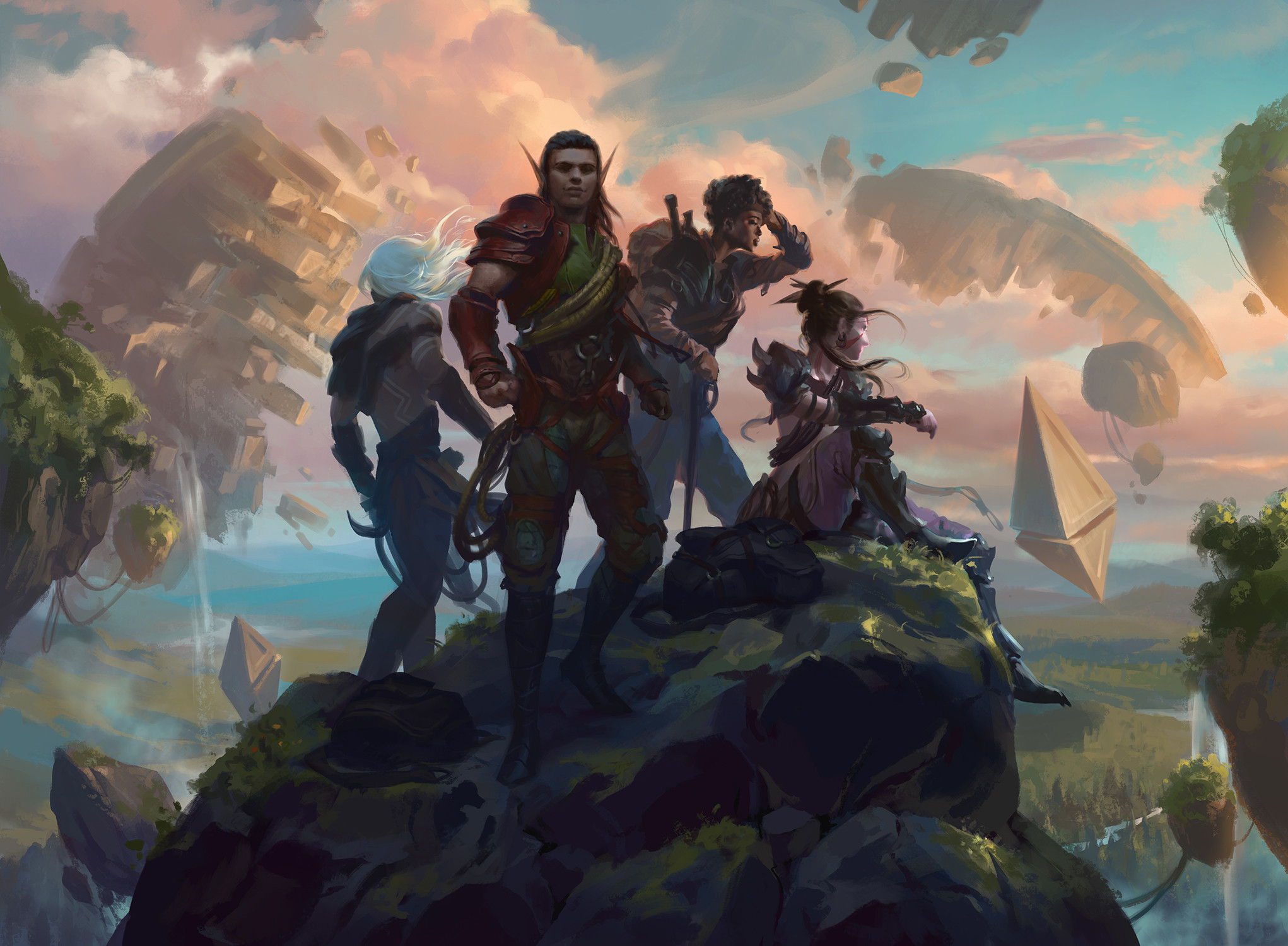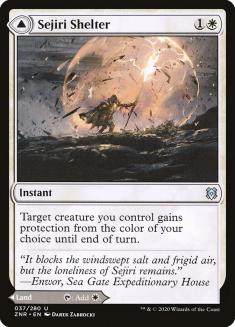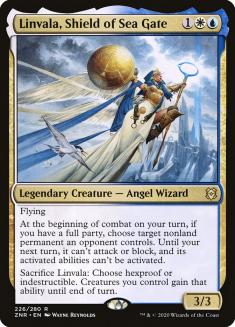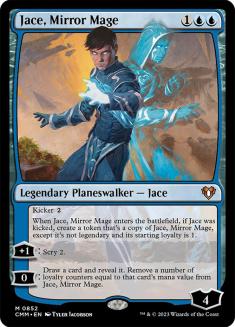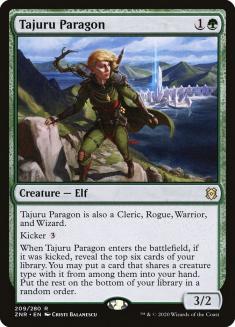It was a banner week for looking at the near-term future of Commander. In addition to the first Zendikar Rising previews (not to mention a cool trailer), we got a peek at the product schedule for the first quarter of 2021, and it’s quite thrilling. There’s plenty to unpack already.
Upcoming Products
You’ll finally get to see the results of what I worked on during my time in Studio X. Although I obviously can’t offer up any details, I can tell you I was a member of the Strixhaven vision design team. I also had some input into Kaldheim and played with some of the cards. I predict both sets are going to be big hits with Commander players. So will be 2021’s Core Set replacement, the Magic/D&D crossover Adventures in the Forgotten Realms.
The hits will keep coming as there will be two Innistrad revisits, one featuring Werewolves, the second featuring Vampires. If that’s not enough, there will also be Time Spiral Remastered, featuring old-bordered time-shifted cards as well as modern-bordered ones. Chalice of the Void was the card they previewed with it, getting folks pretty fired up from the get-go.

Some folks are critical of the pace of releases and point to product fatigue as their primary complaint. I am not one of those people. Yes, if you’re an inveterate collector and absolutely need one of everything ever printed, you’re overwhelmed by now and have been for a few years. The point is that the Magic audience is large enough these days to support a “something for everyone” idea of big-picture product design.
There was a day when they needed to scratch everyone’s itches within each set. I don’t want to go as far as someone else’s “this product is not for you” declaration, but we now have such a broad player base that Studio X can make sets targeted at certain demographics without having to please everyone—since folks who aren’t in that target audience have confidence that there’s something else coming up for them. A whole set can be weak for draft or sketchy for Commander, and that’s fine since we know that won’t be the case for the next release. It’s an incredibly rich time for us as fans of the game. As a content creator, I’m also happy that I have many new things to share my excitement about.
Zendikar Rising
Everyone is abuzz about fetchlands finally getting revealed, but that’s down the list of exciting things about Zendikar Rising for me. We have new and returning mechanics, powerful options for a few creature types, and, of course, just cards. Cards that do stuff. We’ll talk more about cards and commanders in the coming weeks. For today, I’ll focus more on the mechanics, plus some need-to-know rules interactions.
Double-Faced Cards
One of the first things we got a good look at are what they’re calling modal double-faced cards. Like other modal spells, when you cast (or play) them, you choose what you want to do. In the case of these, that choice is which side of the card you want to play, front or back. This being Zendikar, where lands are important, all those we’ve seen so far have lands on at least one side. Some of them are lands on both, creating a new type of two-color land.
In other zones, like your hand, library, or the graveyard, the card exists only as the front face. If you need any info off the card, like type or mana cost, that’s the only thing you look at. You can’t use Life from the Loam to get Emeria’s Call out of the graveyard or pull it out of your library with Expedition Map. The cards are conveniently marked in the upper left so that you can tell which face is the front and which is the back. There’s also a little reminder bar on the bottom of the front that tells you what the back does so that you don’t have to keep pulling it out of the sleeve and flipping it over.
Unlike some other DFCs, these can’t be transformed. Once you’ve chosen a side, you stick with that side while it’s on the battlefield. Of course, if you get it back into your hand, you can cast or play it in either fashion you like. I already use bouncelands, like Rakdos Carnarium, in order to get lands with good enters-the-battlefield triggers back for additional uses. Sometimes you need to Bojuka Bog twice. Living Tsunami (also from original Zendikar) is a good choice for playing your DFC as a land early and getting it back as a spell later. Clearly Trade Routes becomes even better than it already is, since you can activate it to put the land back in your hand and then cast the spell. If it’s an instant, like Valakut Awakening, you can cast it all as part of the same stack. Tricks will abound.
Modal DFCs help solve (or at least mitigate) an ongoing and inherent problem in Magic: mana screw and flood. Now you have lands which can be used as spells and spells that can be used as lands. Drawing an uncastable spell early or a useless land late will now be less of a problem than it used to.
From those we’ve seen so far, it looks like Modal DFCs will be better in formats other than Commander. While potentially useful in a few narrow situations (like Sejiri Shelter being able to punch through that damage you absolutely need), the nonland abilities aren’t quite as splashy as most of the spells the format wants. Emeria’s Call is so far the exception. Obviously, we’ll need to see the full set before making a final judgment.
Speaking of lands, Zendikar Rising features the return of full-art lands, a move which I’d prefer they make for good with all sets. I get that they want full-art ones to be special; I simply find them aesthetically more pleasing in general. And those alternate-art fetchlands (plus Prismatic Vista and Wasteland) are ghost pepper hot.
Getting This Party Started
The mechanic reveal which would have foreshadowed the Forgotten Realms set had they not revealed it at the same time is the concept of the party. Like a classic D&D group, your party consists of a Cleric, a Rogue, a Warrior, and a Wizard. Changelings apply, but one can’t fulfill all the slots. You’ll need four creatures to have a full party. The cards then do things based on the number of members in your party.
Some of the cards have diminished effects but still do something if you don’t have a full a party; others only work if the party is full. For example, Spoils of Adventure costs one less to cast (off its normal 4UW) for each member in your party, that cost locked in when you announce the spell. If your party composition changes once the spell is on the stack, nothing happens. The effect, gaining three life and drawing three cards, is the same no matter how much you paid for it and isn’t dependent on how full your party is.
Linvala, Shield of Sea Gate, however, works only if your party is full. There’s a conditional triggered ability at the beginning of combat, so you check when it would go on the stack and when it resolves. If the condition is still true on resolution, it finishes resolving and then the targeted creature can’t attack, block, or activate its abilities. It doesn’t matter if the specific composition of the party changes in the interim.
For example, you have Linvala as your only Wizard in an otherwise-full party. At your beginning of combat, her ability triggers. While that ability is still on the stack, an opponent wants to dagger you, and casts Murder on Linvala. You sacrifice it in response, giving all your creatures indestructible (which, by the way, you don’t choose until the ability resolves; don’t let anyone trick you into making the choice too early). Then, with that ability on the stack, you flash in Dualcaster Mage (copying their Murder and killing one of their creatures). When Linvala’s triggered ability goes to resolve, it doesn’t care that Linvala filled your Wizard spot at the beginning and Dualcaster Mage fills it now. It only cares that the party is still full.
The mechanic got me looking into existing decks to see if I had any pre-built parties. It doesn’t look like I do. In Animar, I have several Warriors and Wizards, a Shapeshifter, and a few Clones, so it could happen there. It turns out that in my deck suite, I’m shortest on Rogues. I suppose that means I’ll have something to consider when it comes to building decks in the post-Zendikar Rising world.
Returning Mechanics
We know that kicker and landfall will be making a return in Zendikar Rising. Landfall was one of those not-so-hidden secrets; even if folks didn’t have any insider knowledge, it was a strong bet since OG Zendikar was where we first saw the keyword. Kicker has been visited multiple times since its introduction way back in Invasion.
Like DFCs, kicker adds a level of flexibility to how you cast a card, making it an excellent mechanic for assuring you have either early-, mid-, or late-game plays as you need them. I remember Kavu Titan being all the rage, as it was a vanilla Bear on Turn 2 but a brutal monster on Turn 5, helping you curve appropriately. That’s not so much of a concern in Commander, but even in the format of big-mana plays, you want some early action so that you’re not just a sitting duck for the people who have gotten off to a quicker start.
Jace, Mirror Mage is one of the early talked-about cards in the set, since you can cast it normally for the low cost of 1UU. Adding just two more generic mana, you can get another copy that’s not legendary. Of course, if you don’t have creatures to protect it/them, dropping one early is likely to get it stomped out anyway. The good news is that ability to scry or draw is useful, but nothing too dangerous. Add in the fact that there’s no ultimate to work to, and your Jace, Mirror Mage(s) will be safer than other planeswalkers.
The most compelling card with kicker we’ve seen so far is Tajuru Paragon, which plays into the party mechanic. Tajuru Paragon is a multi-classed Elf, being a Cleric, Rogue, Warrior, and Wizard as well. It’s a 3/2 for 1G, which is already better than normal. If you’ve kicked it for the lost cost of three extra, you reveal the top six cards of your library and put one of them that shares a creature type with Tajuru Paragon into your hand. You’ll have party-filling help, but it also simply works in Elf (or any of the other four) tribal. What’s neat is that if you somehow give the Paragon other creature types, like via Arcane Adaptation or Conspiracy, those also apply to what you can get.
One new card and one reprint with landfall have already gotten folks stoked. The reprint is Lotus Cobra, whose landfall gives you benefits for what you’re already doing, playing land. I’m probably not the first person to suggest putting it into your Tatyova, Benthic Druid or Chulane, Teller of Tales deck. And the new alternate-art version is beautiful.
The new one is the latest version of everyone’s favorite legendary Elemental. It’s Omnath, Locus of Creation. We live in an already Omnath-mad world, and this isn’t going to change anything. As many people predicted, Omnath has acquired a fourth color, making it everything except black.
The card demonstrates that designers and developers were paying attention to the possibility that previous Omnath abilities may have gotten out of hand since they were left unbounded. You’re limited to getting three landfall triggers off the new one. Actually, you’ll get the triggers, but nothing will happen, which makes it a unique triggered ability in Magic’s history. On the first, you gain four life. On the second you add one each of Omnath’s four colors (to your mana pool, which no longer exists). On the third, you deal four damage to each opponent and planeswalker you don’t control.
This version of Omnath draws a card when it enters the battlefield, so it makes the necessity of subsequent castings (because it’s inevitably still going to be a target) a little more palatable. Often, four-color commanders feel more like the absence of what they’ve left out instead of the inclusion of what’s in; this Omnath avoids that and definitely feels like what the four-color combo does.
The first week of new set previews is always a time of great hype and excitement. If what we’ve seen in the initial seven days is any indication of what’s to come, hang on to your hat. This party bus is just getting revved up.
Visit my Decklist Database to see my Signature Decks, the Chromatic Project, and more!

